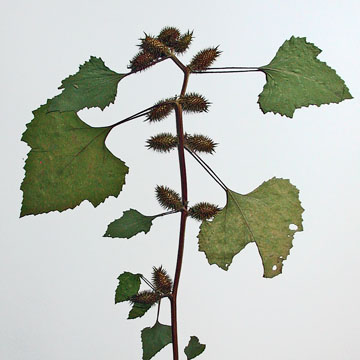

Xanthium strumarium - (image 1 of 4)
Taxonomy
Family: Asteraceae
Habitat
Fields, waste places, flood plains, shores.
Associates
Distribution
Cosmopolitan, probably of New World origin.
Morphology
Annual; stems 20-200 cm, appressed-hairy or subglabrous; leaves long-petiolate, broadly ovate to suborbicular or reniform, typically cordate or subcordate at the base, sometimes shallowly 3-5-lobed, often 15 cm long; staminate heads in a terminal cluster, the pistillate ones in several to many short axillary inflorescences; bur broadly cylindric to ovoid or subglobose, 1-3.5 cm, beset with stout hooked prickles, terminated by two straight or more or less incurved beaks.
Notes
Flowers July to September
Wetland indicator: FAC
Typical X. strumarium has burs that are eglandular with straight terminal beaks and is thought to have originated in tropical America and likely introduced from southern Europe. We have two native varieties that have more or less incurved terminal beaks; var. canadense (Mill.) Torr. & A. Gray is more common and has brownish or yellowish-brownish burs 2-3.5 cm long with the lower part of the prickles spreading-hairy and more or less stipitate-glandular; var. glabratum (DC.) Cronquist is less common and has paler burs rarely over 2 cm long that are merely atomiferous-glandular or glandular-puberulent to subglabrous.
Xanthium spinosum L. is a plant of unknown origin that has lanceolate leaves that taper to the base each with a 3-forked axillary spine in the axil.
References
Gleason, Henry A. and A. Cronquist. 1991. Manual of Vascular Plants of Northeastern United States and Adjacent Canada. Second Ed.
The New York Botanical Garden. Bronx, NY
USDA, NRCS. 2002. The PLANTS Database, Version 3.5 (http://plants.usda.gov).
National Plant Data Center, Baton Rouge, LA 70874-4490 USA.
|
Michael Hough © 2018 |